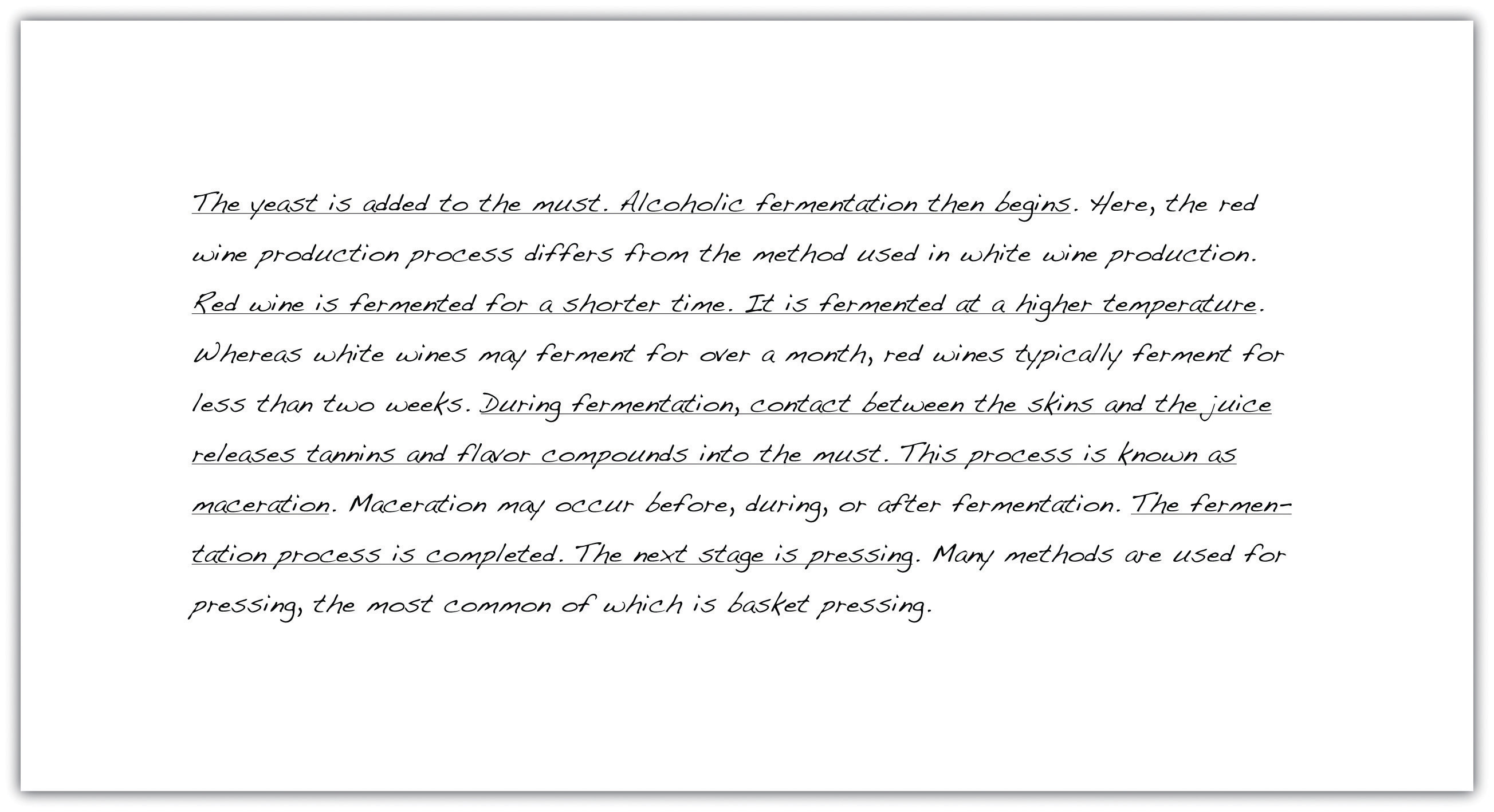G. Coordination and Subordination
What are Coordination and Subordination?
Writers primarily use two important methods of linking ideas together in one sentence: coordination and subordination. Learning to use coordination and subordination well is foundational to creating cohesion (or a smooth flow) in your writing and expressing how your ideas relate to each other logically.
Definitions
Coordination: Joining two related ideas of equal importance
Subordination: Joining two related ideas of unequal importance
Connecting sentences with coordinate or subordinate clauses creates more coherent paragraphs and, in turn, produces more effective writing. In this section, you will read excerpts from an essay about wine production by Noemi, a student writer, as he revises his writing for coordination and subordination. Read this excerpt from Noemi’s essay:
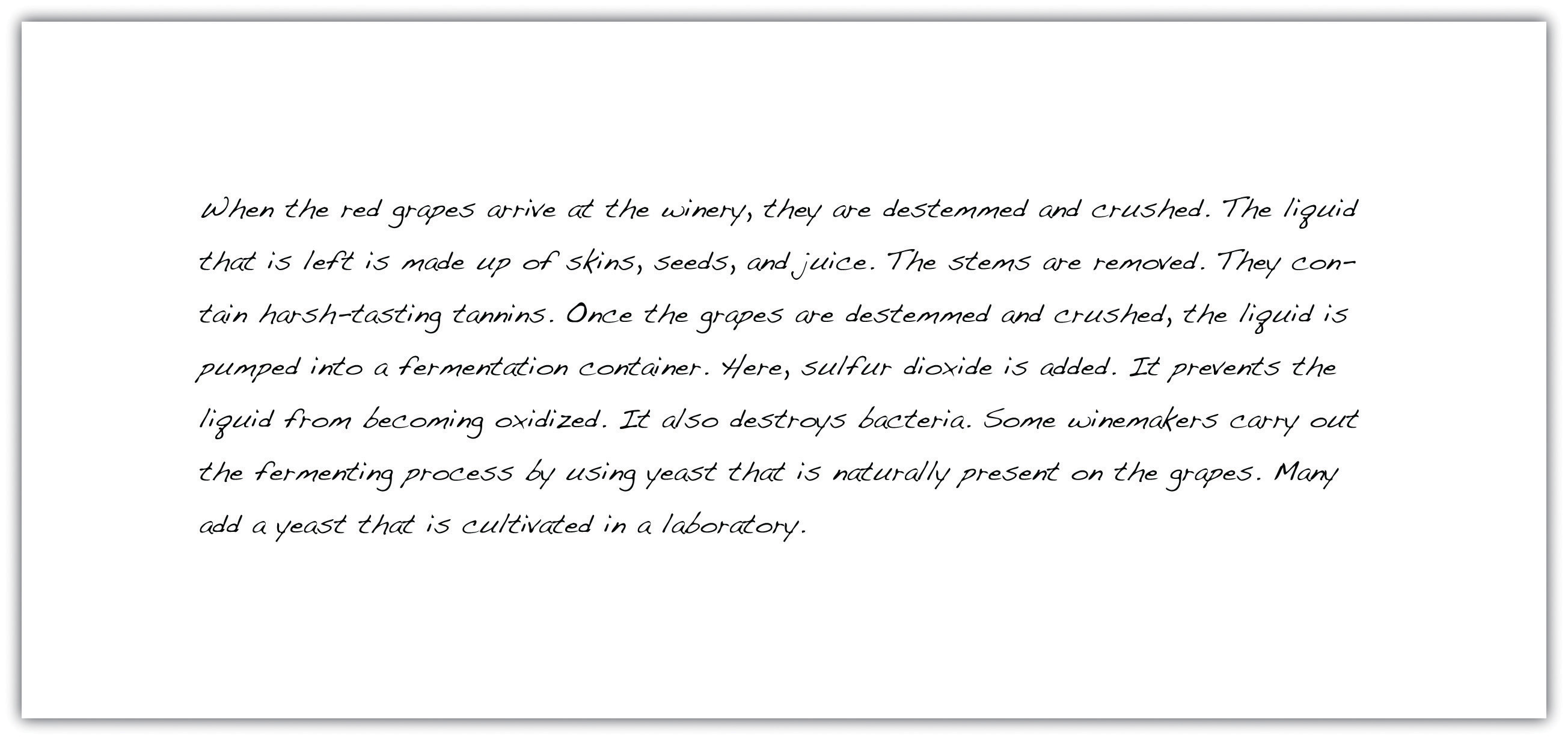
Coordination
Coordination joins two independent clauses that contain related ideas of equal importance.
Original sentences: I spent my entire paycheck last week. I am staying home this weekend.
- In their current form, these sentences contain two separate ideas that may or may not be related. Am I staying home this week because I spent my paycheck, or is there another reason for my lack of enthusiasm to leave the house? To indicate a relationship between the two ideas, we can use the coordinating conjunction so:
Revised sentence: I spent my entire paycheck last week, so I am staying home this weekend.
- The revised sentence illustrates how the two ideas are connected. Notice that the sentence retains two independent clauses (I spent my entire paycheck; I am staying home this weekend) because each can stand alone as a complete idea.
Coordinating Conjunctions
A coordinating conjunction is a word that joins two independent clauses. The coordinating conjunctions are for, and, nor, but, or, yet, and so. These can be memorized by the acronym FANBOYS. Note that a comma precedes the coordinating conjunction when joining two clauses but not when joining a phrase (such as in this sentence).
The following table explains the logic that each coordinating conjunction represents.
| Function/Logic | Coordinating Conjunction | Example |
| cause | for | I had to bring my car to the body shop, for I had run into a pole. |
| addition | and | I strive to find balance in my life and my best friend tries to find balance also. |
| choice/alternative (negative) | nor | I have never been to Europe, nor have I been to Australia. |
| contrast | but | She had packed all her bags for vacation, but the flight was late. |
| choice/alternative | or | Next summer, I can either take a longer RV trip, or I can travel for a shorter period of time and take a train somewhere. |
| contrast | yet | I had tied a scarf around my luggage to find it at the baggage carousel, yet I couldn’t find my bag when I disembarked the plane. |
| effect | so | I had packed almost everything in there, so I felt distraught. |
The next table gives an example of how you might join two clauses with each type of coordinating conjunction.
| Independent Clause | Coordinating Conjunction | Independent Clause | Revised Sentence |
|---|---|---|---|
| I will not be attending the dance. | for (indicates a reason or cause) | I have no one to go with. | I will not be attending the dance, for I have no one to go with. |
| I plan to stay home. | and (adds another idea) | I will complete an essay for class. | I plan to stay home, and I will complete an essay for class. |
| Jessie isn’t going to be at the dance. | nor (indicates a negative) | Tom won’t be there either. | Jessie isn’t going to be at the dance, nor will Tom be there.* |
| The fundraisers are hoping for a record-breaking attendance. | but (indicates a contrast) | I don’t think many people are going. | The fundraisers are hoping for a record-breaking attendance, but I don’t think many people are going. |
| I might go to the next fundraising event. | or (offers an alternative) | I might donate some money to the cause. | I might go to the next fundraising event, or I might donate some money to the cause. |
| My parents are worried that I am antisocial. | yet (indicates contrast) | I have many friends at school. | My parents are worried that I am antisocial, yet I have many friends at school. |
| Buying a new dress is expensive. | so (indicates a result) | By staying home, I will save money.** | Buying a new dress is expensive, so by staying home, I will save money. |
* When using nor, you must change the sentence structure of the second clause you are joining.
** Note that this independent clause (“I will save money) is introduced by a dependent phrase (“By staying home”), hence the comma.
Notice that when joining the following two clauses with “nor,” the subject and the linking verb in the second clause are switched around and the negative “not” is removed because the negative is conveyed through “nor.”
- Original: I did not go shopping this weekend. I did not watch any sports on TV.
- Combined: I did not go shopping this weekend, nor did I watch any sports on TV.
The Coordinating Conjunctions Song (FANBOYS). by Anchor Creative. License: All Rights Reserved. License Terms: Standard YouTube License.
Exercise 1: Join the following sentence pairs with the coordinating conjunction that you feel reflects the logic that holds the two ideas together.
- Ray likes EDM. Kelvin likes rap.
- The book has been on the bestseller list for months it’s one of the most boring novels I have ever read.
- In an earthquake, buildings sway back and forth, many rattle and groan.
- My living room is very small, I should not buy any more furniture.
- Dedicated ecologists do not kill wildlife they shoot with cameras instead of guns.
- Jane is my best friend, she is always there for me when I need her.
- She is not only an excellent student, she is also and outstanding athlete.
- John and Mike enjoyed the movies they wished the seats had been more cozy.
- The TV wasn’t working, I walked over to a friend’s house to watch the game.
- The telephone was ringing, someone was knocking at the front door as well.
- I like action movies, he likes comedies.
- I missed the 8 am bus, I slept through my alarm.
- Something was obviously wrong with the meatloaf, it was glowing in the dark.
- Harry was a good musician he could never keep a steady job in a band.
- Mark is not very interested in sports, he does however, like to water ski.
- I was happy with my new apartment it was in a good location and the rent was low.
Exercise 2: Fix the coordinating conjunction punctuation where needed in the following sentences. Remember that coordinating conjunctions that join two complete ideas (clauses) must have a comma before them. Coordinating conjunctions that join a phrase (part of a sentence) to another sentence structure do not need a comma before them.
- Diego was amazed by the selection of items he could find when shopping online yet he had a hard time picturing how clothes would look on him.
- Beth was horrified, but fascinated by the effects of consumer culture on people.
- Earl was fearful of COVID-19 but he still went out and protested as he felt it was more important.
- Pandemics are more likely to happen because of global warming, and increasing pressure on wild animals.
- Change can happen when people of all races, and creeds stop treating each other in ways they wouldn’t treat themselves.
Conjunctive Adverbs
Another method of joining two independent clauses with related and equal ideas is to use a conjunctive adverb and a semicolon. A conjunctive adverb is a linking word that demonstrates a relationship between two clauses. The punctuation of a conjunctive adverb varies depending on where in the sentence the adverb appears. Once joined, the following sentences show cause and effect.
Original sentences: Bridget wants to take part in the next Olympics. She trains every day.
- Since these sentences contain two equal and related ideas, they may be joined using a conjunctive adverb. Now, read the revised sentence:
Revised sentence: Bridget wants to take part in the next Olympics; therefore, she trains every day.
- The revised sentence explains the relationship between Bridget’s desire to take part in the next Olympics and her daily training. Notice that the conjunctive adverb comes after a semicolon that separates the two clauses and is followed by a comma.
Review the following chart of some common conjunctive adverbs with examples of how they are used:
| Function | Conjunctive Adverb | Example |
|---|---|---|
| Addition | also, furthermore, moreover, similarly, likewise | Alicia was late for class and stuck in traffic; furthermore, her shoe heel had broken, and she had forgotten her lunch. |
| Contrast | instead, however, otherwise | Most people do not walk to work; instead, they drive or take the train. |
| Emphasis | namely, certainly, indeed | The Siberian tiger is a rare creature; indeed, there are fewer than five hundred left in the wild. |
| Cause and Effect | accordingly, as a result, consequently, hence, thus, therefore | I missed my train this morning; consequently, I was late for my meeting. |
| Time | finally, next, subsequently, then, after | Tim crossed the barrier, jumped over the wall, and pushed through the hole in the fence; finally, he made it to the station. |
| Condition | otherwise | The hotel room will hopefully be ready when I arrive; otherwise, I will have to leave my luggage in the car. |
| Choice/Alternative | alternatively, on the other hand, conversely | I can continue with my current job and try to improve the situation; alternatively, I can quit and try to find a new position. |
Take a look at Noemi’s essay on wine production again and identify some areas in which he might use coordination.
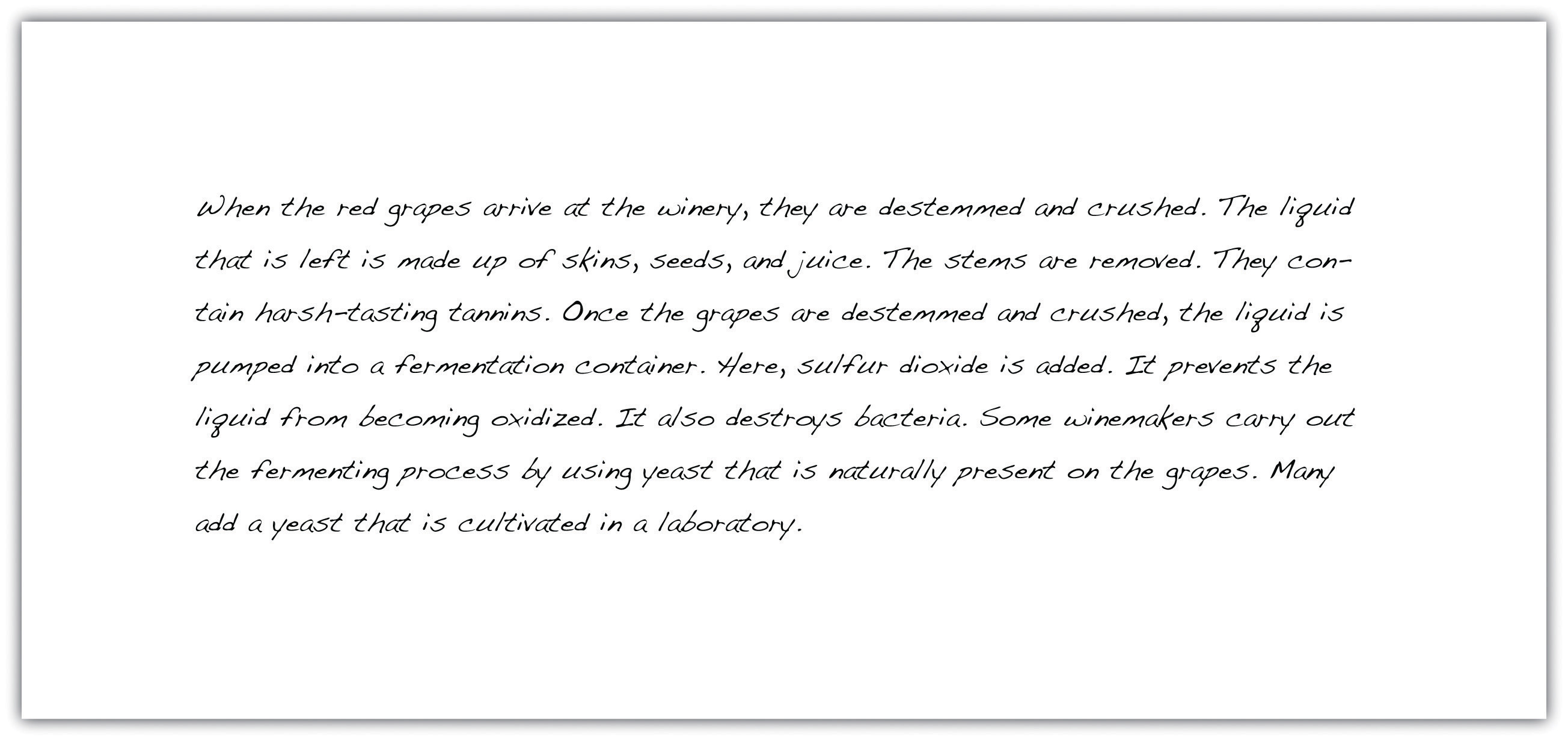

Tip: Punctuating Transitional Adverbs
Transitional adverbs can be tricky to punctuate. If the transitional adverb is used between the two clauses, place a semi-colon before the transitional adverb and a comma after, such as in the following sentence:
They were looking forward to going home for the semester break; however, they had to finish finals first.
If the transitional adverb appears in the middle of the second clause of the sentence (it should never appear in the first), it should be punctuated with commas on both sides, as in the following sentence.
They were looking forward to going home for the semester break. They, however, had to finish finals first.
Finally, if the transitional adverb appears at the end of the second clause, it should be punctuated with a comma before and a period after (the end of the sentence).
They were looking forward to going home for the semester break. They had to finish finals first, however.
Exercise 3: Combine each sentence pair into a single sentence using a conjunctive adverb. Then copy the combined sentence onto your own sheet of paper.
- Pets are not allowed in Mr. Taylor’s building. He owns several cats and a parrot.
- New legislation prevents drivers from sending or reading text messages while driving. Many people continue to use their phones illegally.
- The coroner concluded that the young man had taken a lethal concoction of drugs. By the time his relatives found him, nothing could be done.
- Amphibians are vertebrates that live on land and in the water. Flatworms are invertebrates that live only in water.
- Ashley carefully fed and watered her tomato plants all summer. The tomatoes grew juicy and ripe.
- When he lost his car key, Simon attempted to open the door with a wire hanger, a credit card, and a paper clip. He called the manufacturer for advice.
Collaboration
Please share with a classmate and compare your answers.
Subordination
Subordination joins two sentences with related ideas by merging them into a main clause (a complete sentence) and a dependent clause (a construction that relies on the main clause to complete its meaning). Unlike coordination, which allows a writer to give equal weight to the two ideas that are being combined, subordination enables a writer to emphasize one idea over the other. Take a look at the following sentences:
Original sentences: Tracy stopped to help the injured man. She would be late for work.
- To illustrate how these two ideas are related, we can rewrite them as a single sentence using the subordinating conjunction even though.
Revised sentence: Even though Tracy would be late for work, she stopped to help the injured man.
- In the revised version, we now have an independent clause (she stopped to help the injured man) that stands as a complete sentence and a dependent clause (even though Tracy would be late for work) that is subordinate to the main clause.
- Notice that the revised sentence emphasizes the fact that Tracy stopped to help the injured man, rather than the fact she would be late for work. We could also write the sentence this way:
Revised sentence: Tracy stopped to help the injured man even though she would be late for work.
- The meaning remains the same in both sentences, with the subordinating conjunction even though introducing the dependent clause.
Tip
Subordinating Punctuation
To punctuate sentences correctly, look at the position of the main clause and the subordinate clause. If a subordinate clause precedes the main clause, use a comma between the two clauses. If the subordinate clause follows the main clause, no punctuation is needed.
The Subordinating Conjunctions Song. Provided by: Anchor Creative. License: All Rights Reserved. License Terms: Standard YouTube License.
Subordinating Conjunctions
A subordinating conjunction is a word that joins a subordinate (dependent) clause to a main (independent) clause. Review the following chart of some common subordinating conjunctions and examples of how they are used:
| Function | Subordinating Conjunction | Example |
|---|---|---|
| Concession | although, while, though, whereas, even though | Sarah completed her report even though she had to stay late to get it done. |
| Condition | if, unless, until | Until we know what is causing the problem, we will not be able to fix it. |
| Manner | as if, as, though | Everyone in the conference room stopped talking at once, as though they had been stunned into silence. |
| Place | where, wherever | Rita is in San Jose where she has several important client meetings. |
| Cause | because, since, so that, in order that | Because the air conditioning was turned up so high, everyone in the office wore sweaters. |
| Time | after, before, while, once, when | After the meeting had finished, we all went to lunch. |
Take a look at the excerpt from Noemi’s essay and identify some areas in which he might use subordination.
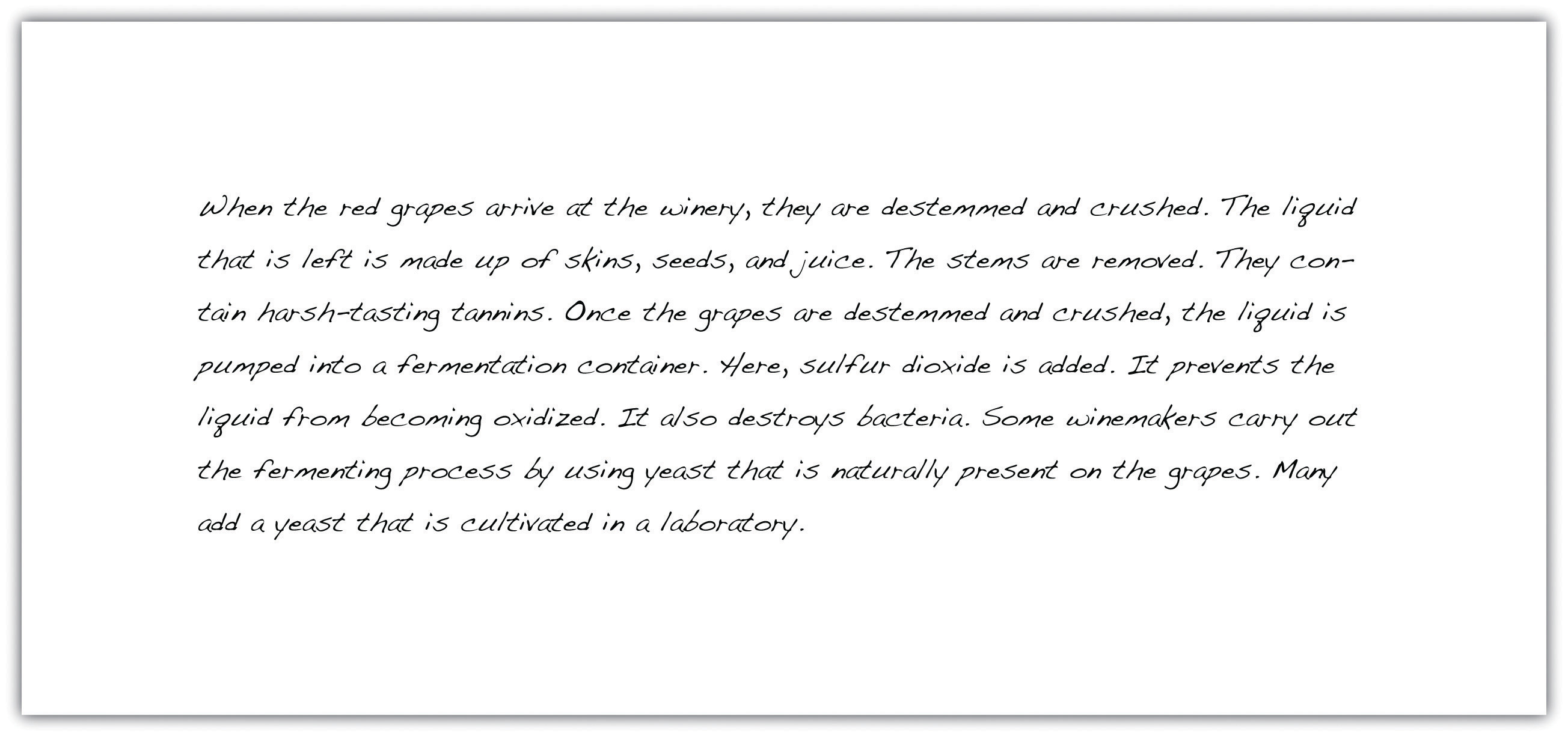
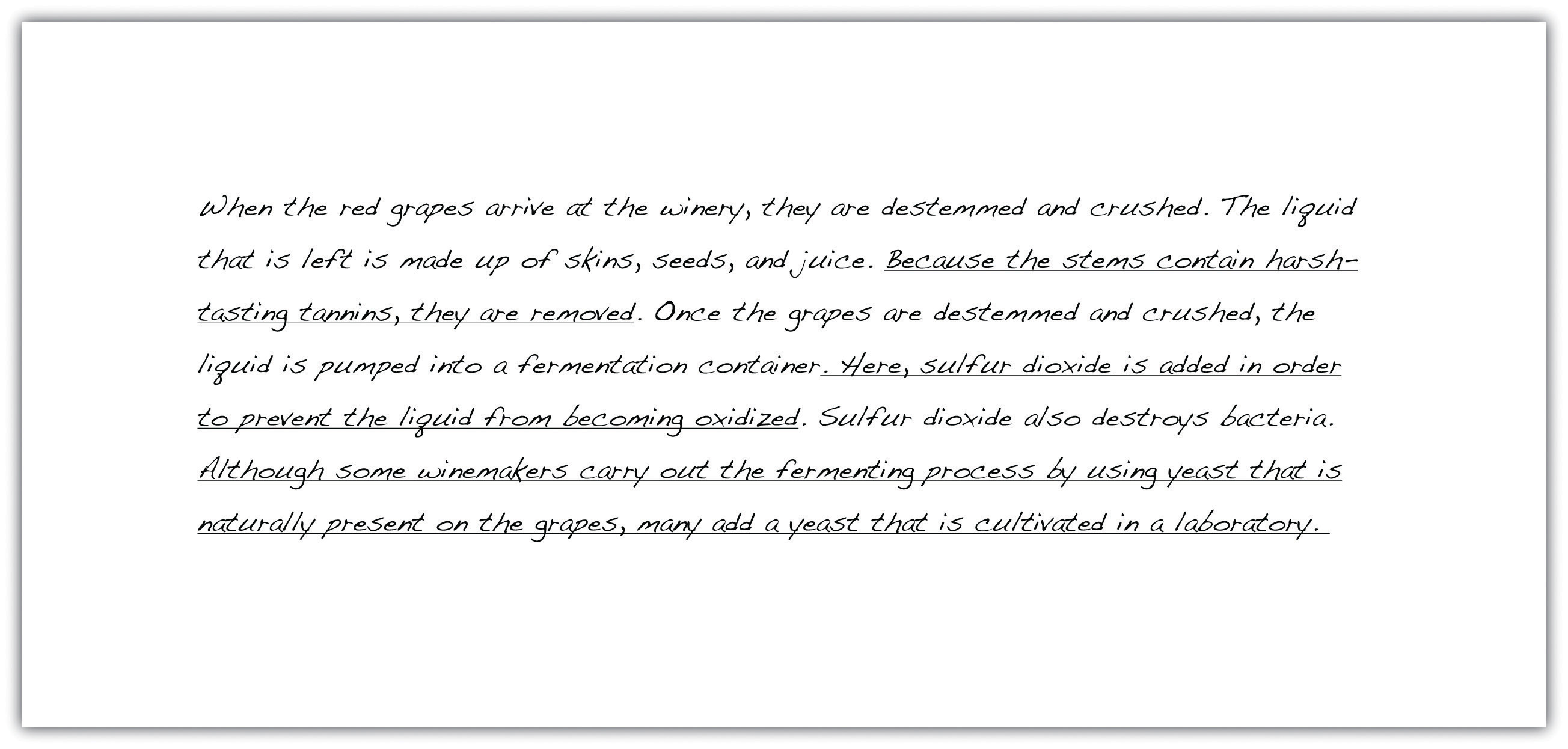
Exercise 4
Combine each sentence pair into a single sentence using a subordinating conjunction and then copy the combined sentence onto your own sheet of paper. Check your revised sentences for correct punctuation.
- Jake is going to Mexico. There are beautiful beaches there.
- A snowstorm disrupted traffic all over the East Coast. There will be long delivery delays this week.
- My neighbor had his television volume turned up too high. I banged on his door and asked him to keep the noise down.
- Jessica prepared the potato salad and the sautéed vegetables. Jordan marinated the chicken.
- Romeo poisons himself. Juliet awakes to find Romeo dead and stabs herself with a dagger.
Exercise 5
Copy the paragraph from Joshua’s essay onto your own sheet of paper. Then edit using the techniques you have learned in this section. Join the underlined sentences using coordination or subordination. Check your revised sentences for punctuation.
LICENSE AND ATTRIBUTION
“Coordination and Subordination” adapted from “11.7: Coordination and Subordination” of Writing, Reading, and College Success: A First-Year Composition Course for All Learners (Kashyap and Dyquisto), used according to creative commons CC BY-SA 4.0.

